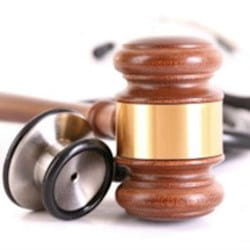A mother attends a GP surgery with her three-year old son – Peter – who has a soft swelling near the navel. She sees the family’s regular GP, Dr L, who suspects an umbilical hernia. He explains to Peter’s mother that the condition is probably not serious but he will refer the boy to a paediatric surgeon. In the same consultation the mother expresses some concern about Peter’s walking posture and Dr L notices that the boy seems rather flat-footed. He mentions this also in his letter to the paediatric surgeon.
Peter sees the paediatric surgeon a few weeks later who confirms the umbilical hernia but takes the view that it is not of immediate concern. He also notes the boy’s flat feet and recommends instep supports. A six-month follow-up is arranged and when Peter returns to the surgical clinic his parents report that the insteps seemed to improve the boy’s gait only for a short period and he is now walking with a limp.
The surgeon arranges a hip X-ray and the result shows a congenital dislocation of the right hip (CDH). Peter is referred to an orthopaedic surgeon for treatment including traction, open reduction and a pelvic osteotomy. The boy heals fully from the procedure but there is need for a proximal femoral realignment as the femoral head remains slightly subluxed. The orthopaedic surgeon explains to Peter’s parents that late CDH of this sort can be problematic to correct.
A few months later Dr L receives a letter from solicitors representing Peter’s parents intimating a potential claim for medical negligence in the late diagnosis of the CDH.
Analysis and outcome
Dr L contacts an MDDUS adviser who arranges for a medical expert to review Peter’s notes. Here it is noted that that the boy underwent routine checks at 7 and 14 months with specific mention that the hips were normal. Peter was also observed by a health visitor to be walking well at 16 months including up and down stairs. In his first three years Peter was seen numerous times at the practice for minor infections and vaccinations. First reference to the gait problems is when Peter attends for the umbilical hernia.
In her report the medical expert comments: “Screening procedures are designed to pick up early signs of particular problems, especially those, such as congenital dislocation of the hip, where early intervention may make a considerable difference to the outcome. However they are not 100% guaranteed and, despite careful examination, can miss the condition being screened for. It is always unfortunate when this occurs, but the GP, having carried out the examination in the recognised manner, cannot be considered negligent if it unfortunately presents at a later date.”
The expert only questions the actions of the paediatric surgeon in delaying further investigation of Peter’s gait abnormality by 6 months but her report is in reference to Dr L’s actions alone. MDDUS replies robustly to the solicitors in regard to Peter’s treatment by Dr L and the case against the GP is not pursued.
Key points
- Ensure clear records are kept of all examinations including negative findings.
- To establish medical negligence it must be proved that a doctor is guilty of a failure that no doctor of ordinary skill would commit if acting with reasonable care.
- Have a high index of suspicion in gait abnormalities beyond age 3.
This page was correct at the time of publication. Any guidance is intended as general guidance for members only. If you are a member and need specific advice relating to your own circumstances, please contact one of our advisers.
Save this article
Save this article to a list of favourite articles which members can access in their account.
Save to library


